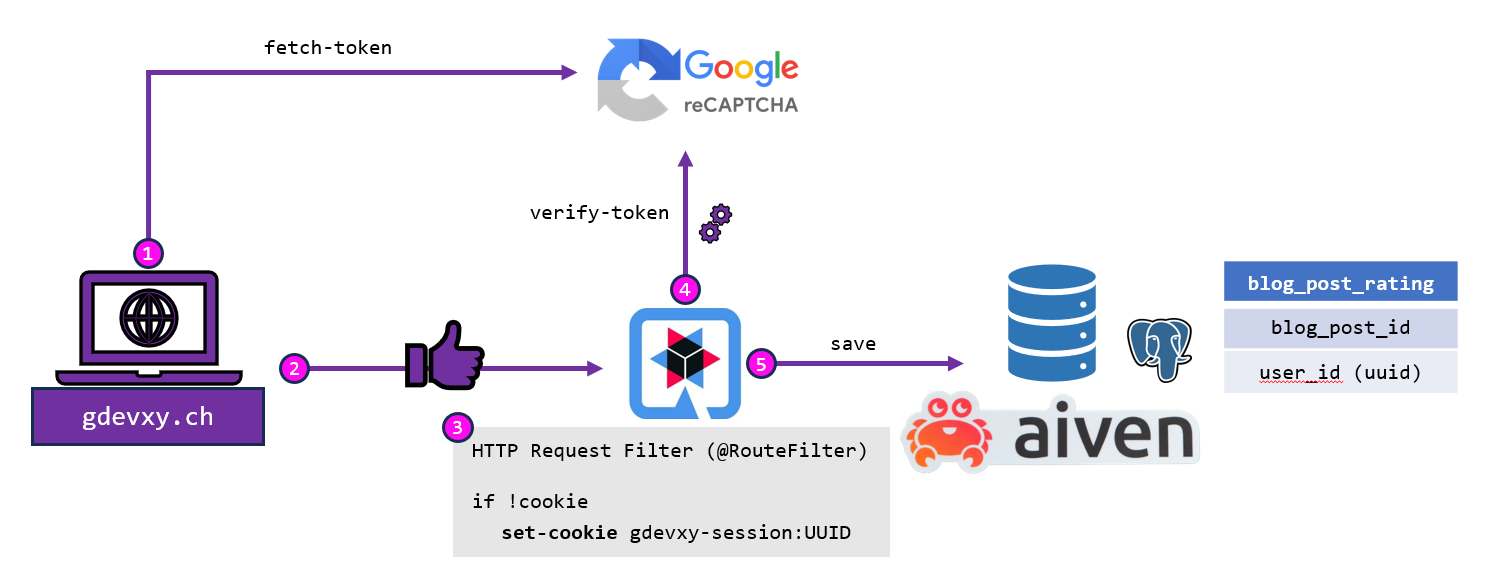
Give me one!
Freshly added you can now 👍 a blog post. It's the kind of feature absolutely not crucial but so much fun to make because it involves many little aspects...
# Introduction
When starting an application from scratch, the fundamental question of
what features should I build first?
will inevitably arise. For some, the answer might be
ROI! First to market! Customer needs!
Well, for me, it's simply about building something
fun
. Yes,
fun
. This is my blog, and I don't particularly care if a feature is meaningful, as long as I have fun implementing it. 😊
With that said, here is the 👍 feature that I particularly enjoyed creating.
# Architecture & Code
What I don't want is for my blog to feel cumbersome for visitors. I want a safe place where I can share my thoughts, while also being inclusive—a space where people can easily provide feedback. The challenge, however, is that if there are no validations, such functionalities may become vulnerable to bots, making them meaningless in no time.

# Fraud mitigation
The first step is, consequently, to mitigate the risk of fraud and fake votes. I decided to use
reCAPTCHA v3
, which, unlike v2, is fully transparent and does not require human intervention (e.g. puzzle solving). While there are
limitations
to using this service, I don’t expect heavy traffic, nor do I care if botnets decide to DDoS my tiny personal blog. The use of
reCAPTCHA
will most likely be extended to other features in the future, such as the ability to react (comment or reply) to blog posts.
# User identification
The second challenge is user identification. If there’s no registration involved, how can I persist the fact that someone liked a post? There are probably various ways to solve this puzzle, but one elegant solution is to consider the browser as the lowest common denominator.
The first step is to generate some kind of
session ID
(UUID) to identify the visitor. This ID is then passed down to the browser and expected back in subsequent calls. Does that ring a bell? Yes,
cookies
! That’s exactly what they’re made for. 🍪
@RouteFilter(100)
public void sessionRouteFilter(RoutingContext ctx) {
var session = Cookies.findSessionCookie(ctx.request());
if (session.isEmpty()) {
ctx.response().addCookie(Cookies.createSessionCookie());
}
ctx.next();
}
When a visitor likes a post, the
session ID
(UUID) is first extracted from the cookie and then persisted in the
blog_post_rating(id, user_id)
SQL table. Each entry simply represents a like. And there you have it—easy as lemon squeezy! 🍋🍸
# Persistence
The final concern was choosing a database provider. This project is hosted on
Oracle Cloud
, but their pricing for a cloud SQL database is far beyond my expense limit for this project. I explored various free alternatives that would offer enough flexibility for my current needs, and provide affordable paid tiers for scalability if necessary.
I went for
aiven.io
, which not only provides a free tier that perfectly fits my requirements but is also incredibly user-friendly.

# Wrap up
- Consider Google reCAPATCHA v3 for transparent, seamless and bot-resistant protection
- Guest user identification by leveraging cookies 🍪 as persistence context
- aiven.io as free cloud provider for SQL databases
This project is publicly accessible on my
github
and ... don't forget to leave a thumbs up 🙃.
Leave a thumbs up
Leave a thumbs up if you liked it